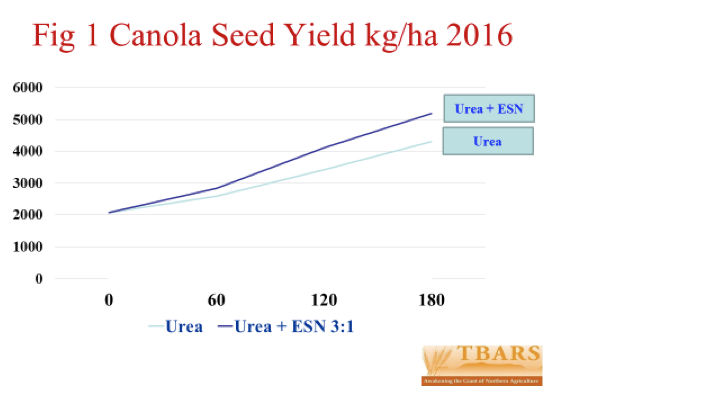I initiated research on nutrient management in canola in 2004. During 2004-’06, increasing response to nitrogen was obtained up to 150 kg N/ha and the maximum seed yield obtained was 5 MT/ha. Further increase of N rate to 200 kg/ha didn’t help even though the soil and weather conditions were conducive to good canola growth and development. Hyola 401, a conventional canola variety, was grown then to gauge response of N to canola. Sulphur (S) and Boron (B) were part of the experiment. In 2013, with Liberty 150 SN, we recorded a maximum canola seed yield of over 6.1 MT/ha with 150 kg N/ha. In 2016, with Liberty 5440 maximum canola seed yield was ~5.92 MT/ha with N @ 180 kg/ha (120 kg N/ha from urea and 60 kg N/ha from ESN). Urea + ESN blend gave nearly 900 kg/ha higher seed yield than urea alone. See Figure 1:

N in this experiment was supplemented with P and K as per soil tests, 24 kg S/ha, 7 kg Zn/ha and 1 kg B/ha. The real pleasant surprises came in 2017 when we obtained 7.93 MT/ha canola seed yield with L230 supplied with 200 kg N/ha and supplemented with other nutrients (P, K, S and Mn, but no Zn). In another experiment to maximize canola seed yield, I added a rate higher than 180 kg N/ha since the response to N was linear up to 180 kg N/ha in 2016. To my surprise the response to N, especially with urea was linear up to 240 kg N/ha with a record high seed (9.6 MT/ha; see Figure 2) and straw (11.9 MT/ha) yield.

I knew that as per Liebig’s Law of Minimum, the yield could be limited by the most deficient nutrient and I wanted to make sure that no nutrient was lacking and the crop was well protected from diseases, if any (to ensure better response to N). Nitrogen was therefore supplemented with 30 kg P2O5+ 58 kg K2O + 25 kg S + 2 kg Mn (as manganese sulphate spray just before bolting) + 1 kg B + 7 kg Zn/ha. Nitrogen above 120 kg N/ha was applied in two splits; up to 120 kg N/ha at seeding along with all other nutrients except Mn and rest of the N was broadcast just before bolting. As we all know, yield is primarily a function of interactive effects of genetics, weather and management. I made sure to pick up a highest yielding variety L252 that gave highest yield among canola varieties in 2016 and made sure that no nutrient was limiting. In addition, Proline fungicide was sprayed at 25 % flowering for protection from diseases; especially Sclerotinia stem rot. Canola was seeded in this experiment on May 25 and was harvested on September 12. Seasonal rainfall (409 ml) was a little above normal and at no stage crop suffered from water stress. Good genetics, good fertility and good soil moisture worked wonders and we had a record breaking/unbelievably high canola seed yield (9.6 MT/ha) in 2017! But for a short period of heat stress (temperature rose to 30oC during last week of July and to 31oC on August 1), canola seed yield could even we higher! The heat stress did hit some flowers, but fortunately by then pod formation was more or less complete*; see Figure 3. The challenge is to translate this type of yield on farms. However, I am reasonably sure that this can be done by growing a high yielding canola variety seeded in time, supplied with abundant and balanced nutrients and protected from crop diseases as was the case in this experiment at TBARS Thunder Bay.

The question that may arise in readers’ minds is; will this type of nutrient use be economical? The answer is YES! See my calculations as follows:
Value of 9,592 kg seed yield/ha = $4,976.00/ha (@ $500/MT; our farmers got up to $530/MT).
Nutrients + Proline cost: $531.12/ha
Cost Benefit Ratio: 1:9.36 i.e. a dollar invested in canola nutrition/and protection will bring $9.36 in return. Including straw the return will be $10.22 (assuming a conservative production of 15 big straw bales/ha; each sold at $30.00!).
One would question there are other costs too! Yes, those could be $717.38/ha (as per OMAFRA Field Crops Budgets); which will raise the total cost of canola production to: $1248.5/ha. Net Returns excluding straw could be: $3,727.50/ha ($4,976.00 minus $1248.5) and with straw would be $4,177.5/ha ($4,976.00 + $450.00 – $1248.5). This means $3.35 return on each dollar spent on canola production! Do we get such a return on investment in crop production in all crops? I don’t think so!
It will be worth taking this research further with rates of N higher than 240 kg N/ha, because the response to N, at least in urea, was linear up to 240 kg N/ha. Please remember that higher and higher crop yields will remove more and more nutrients (both macro and micro) and will need to be supplemented fertilizer nutrients. I would recommend farmers to use multiple sources of N for canola/and other crops production (ammonium sulphate to meet S requirements and rest of the N, 2/3rdas urea and 1/3rdas ESN). Both ammonium sulphate and ESN can retain N longer than urea, which will ensure consistent supply of N to crops up to maturity; and I believe that the practice could obviate the need for split application of N! Any questions? Please feel free to contact me at Drtssahota@gmail.com/or at 807-473-5707 till January 23/or after March 4, 2018. In between I will be out of country. *Canola seeded on farms in June was impacted by this heat stress.
Published in Ontario Farmer, February 6, 2018, Page B4 and Northwest Link, March 2018, Pages 6-7!

